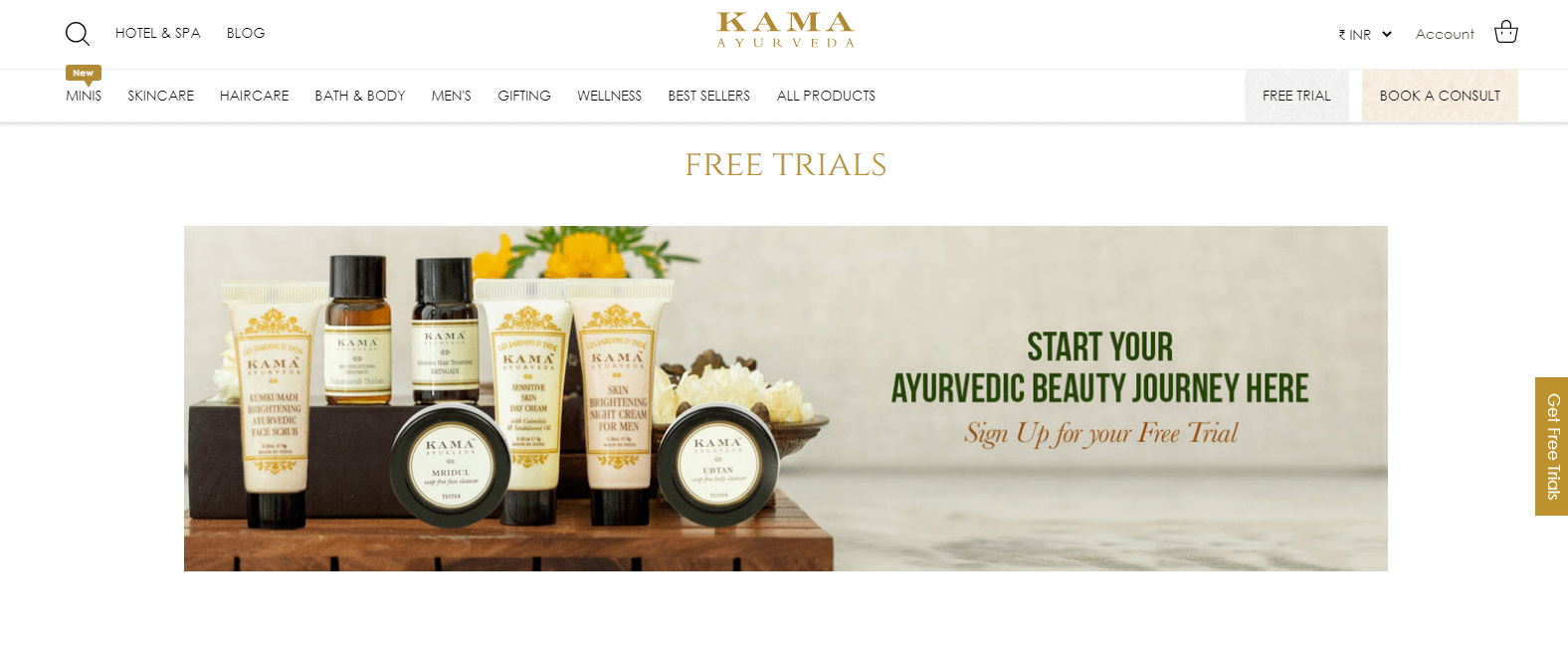Imagine this: you run a survey and find that most of your customers say that your products are too expensive, but they would have purchased if you had reduced the price or offered a discount. This is a common response when doing customer research.
There are two ways to address this problem:
- You can reduce your prices or offer discounts on your ecommerce store. This is easy to do but harder on your profit margin.
- You can communicate the value of your ecommerce products or services effectively. This is hard to do but better for your ecom business in the long run.
We’ll be looking at the second option throughout this article to better understand the value of communicating the perceived value of your products.
Why Is Perceived Value Important?
The perception of value is what customers think your products are worth and what they’re willing to pay for them. Customers have a hard time figuring out the actual value or cost of the products or services they buy. The perceived value of one product over another is based on branding, emotion, and how well you can communicate the uniqueness of your product over other options.
I’ll preface the rest of this article by saying, Don’t lie about the value of your products. I’ve seen this multiple times on drop-shipping and other ecommerce stores. As a business owner looking to make your business last, ask yourself, “How can I make my customers happy and show them what a great product I have?” Give your customers real value when they come to your ecommerce store.
Proving Actual Value to Customers
There are several approaches to proving actual value.
Free trials and guarantees
The best thing you can do to prove that your products are the best is to let your customers try them out. Free trials let your products do the talking for you.
Free-trial offer
On Kama Ayurveda’s site, they offer a free sample-sized product for their customers because they believe in their product. They even have a “Get Free Trials” button on the side of each page on their website. This can easily be a “Free + Shipping” offer in which you offer your product for free but customers have to pay for shipping.
Tip: Sending someone a free trial captures your customer’s information for retargeting later, a plus for your business.
This can work for any ecommerce store:
- Subscription model: offer the first product or box free or offer a sampler that costs only $5.00 so customers can try out all of your products.
- Nonsubscription model: Having a 100% money-back guarantee along with an amazing returns policy can help ease customers’ fear and increase the overall perceived value of your product. This communicates that you, as a store owner, believe in your products and are willing to cover the cost if customers are unhappy.
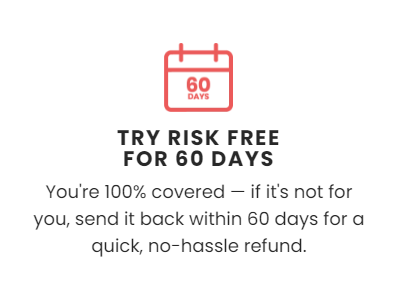
Money-back guarantee
This is Manta Sleep’s money-back guarantee that they proudly display on their ecommerce product page. It effectively communicates their return and refund policy and helps improve the customer’s perception of quality because the business actually believes in the product’s value.
Reviews
Another way to prove the value of your product is with customer reviews and testimonials. Having these is essential for any online ecommerce store. If you don’t have them already, you should be incentivizing your customers through discounts or gift cards to acquire reviews and testimonials.
Nothing is better for communicating value than when you have your own customers telling others that they love the product.
Here’s an amazing review—the reviewer wrote a whole paragraph about it! This convinces customers of the value of your product hands down. It would be even better to have a customer photo or a video that went with the review on your product page.

Lengthy product review
Branding and Aesthetics Matter
You walk into a restaurant and notice it’s dirty and run-down. Are you going to trust the food? Most likely not! Even if the food is amazing, your first perception is going to send you out of the restaurant. The same goes for ecommerce stores.
Make sure that your ecom store has the correct branding color palette, functions well, and is simple and easy to understand. This can greatly increase the perceived value of your store.
Images
Make sure that you have professional photos taken of your products. This is essential, and there’s no way around it. If customers come to your store and see blurry images (i.e., snapshot-of-UFO quality!), then this will decrease the perceived value of your products.
Note: For more about product images, see this BGS video.
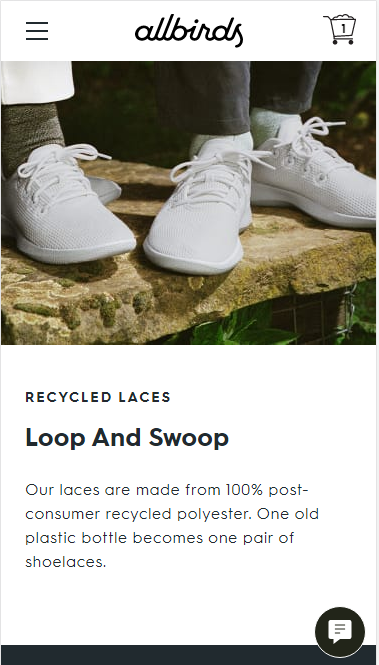
Screaming high value with product images
Allbirds’ product imagery is varied and done by a professional. Their site is also clean and simple and easy to read.
Packaging
You can increase perceived value with your product packaging as well. Making sure packaging is on point makes for happy customers and encourages sharing on social media. Most customers love to see the product wrapped like a gift. Adding a personal thank you message or coupon for future purchases can also encourage them to return. Another trend is nonplastic packaging; customers love seeing this, and it means you can say your business is good for the environment.
Reframing Your Pricing
Pricing can be shown in multiple ways to ease the pain point of cost.
Compare to everyday prices
It’s effective to reframe your pricing by calculating what your customer values and showing them how much time or money they’ll save. For example, say you have a product worth $59.99. You can reframe this by saying it only costs “three large pizzas.” This increases the perceived value of your product because you’re using your customers’ everyday purchases to justify cost.
Compare to competitor’s prices
Another way to reframe your pricing is to compare it to competitors’ pricing.
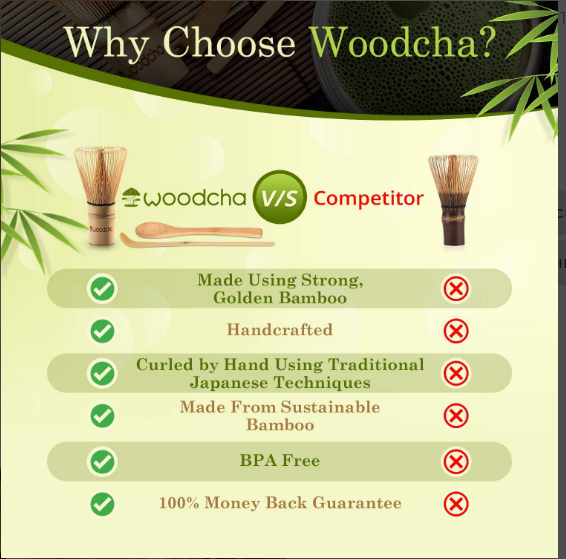
Competitor price comparison
This chart shows the value of your product over your competitor’s. Don’t stretch the facts—be as transparent as possible and highlight your benefits over those of others.
Note: I wouldn’t have all of your competitor’s options crossed out; that can make some customers doubt you.
Compare to previous product prices
An easy way to reframe your pricing is to show your own “compare” price—the price your product was originally versus what it is now.
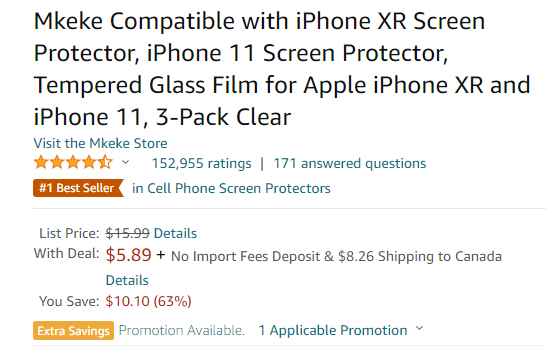
List price versus current price
In this example from Amazon, you see both the listing price and the current price with the deal. They even go a step further and show how much customers will be saving. Customers love deals. If you can reframe your pricing as an irresistible offer, then you can improve the perceived value and your conversion rate.
Be careful though: you can get into territory where customers don’t believe your pricing or that the original listing price is real.
Charity and Social Responsibility
You can affect the perceived value of your product by associating your ecom business with a charity, cause, or socially responsible stance. People are more likely to buy something if they know some of the money is going to a good cause.
Charity
Connecting charity with ecommerce is a win-win, not only for businesses but also for improving and helping out our world.
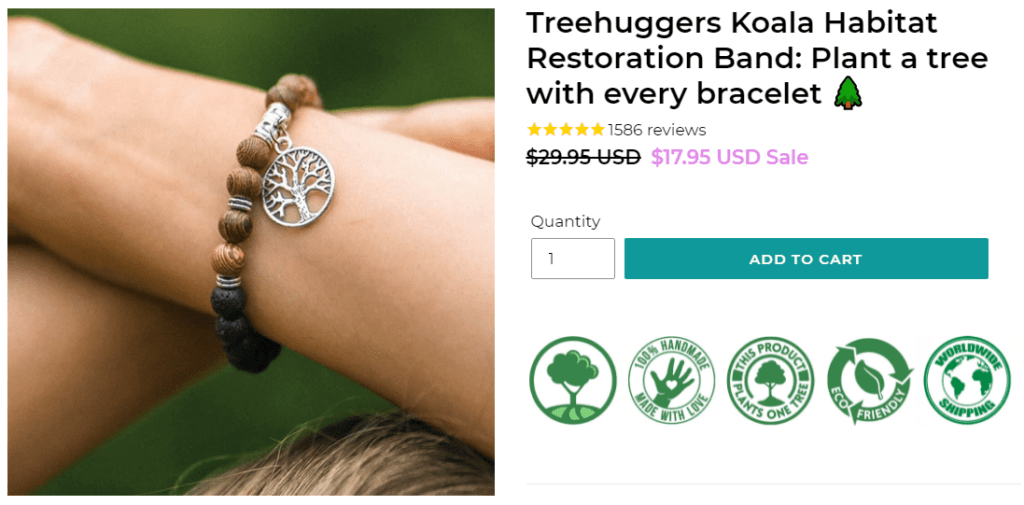
Planting a tree for every bracelet bought
Here’s a great example of linking a product and a cause. This was very popular when Australia had severe forest fires in June 2019. For every bracelet purchased, the company would plant a tree in Australia to help koalas.
At $17.95, the price is quite high for this bracelet, but the value is perceived value as justified because of the tree planting and the good cause. Joining up with a charity or cause might help turn your product from loser to winner.
Social responsibility
Customers also value social responsibility. If your business is using eco-friendly materials and packaging, then communicate that. If your business supports local talent, then tell your customers how.
This goes hand in hand with your About Us page. Most people won’t look at your About Us page, but some may want to know more about your company. If you can effectively communicate your business story and be transparent and honest about it, then the value of your business will go up in the eyes of consumers. You have to have a great story, though, and keep it entertaining. Don’t make it corporate; people want to see how real you are.
Scarcity
It’s simple economics, really! If demand is greater than supply, then you can charge a higher price. Scarcity is a great way to increase overall perceived value because people fear missing out on a great opportunity.
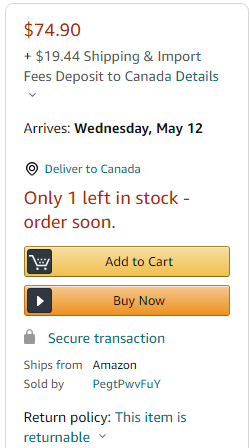
Stock count
Take a look at how Amazon does it. They show the customer this message if something is low in stock. This is one of the easiest ways to show scarcity.
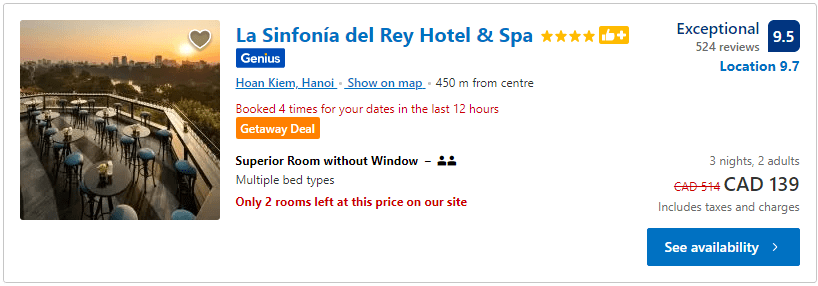
Room count
Booking.com is a website I frequently use, and they’re notorious among marketers for their scarcity tactics. Notice that they actually have two scarcity messages. The first tells you how many times a room (presumably like yours) has been booked in a given time period, which indicates that this hotel must be in high demand. They then hit you with a second line that indicates a limit to the supply that they have at this price.
Notice how they didn’t say that the price could go up or that they still have 10 rooms at that price? You don’t always have to base scarcity on the stock of your products. In this case, it’s about the time frame for a certain price.
Another scarcity tactic that’s easy to implement is a “back in stock” product badge on items that you know will come back in stock. If those badges show up on various products while customers are browsing your collection page, then they know that your products sell quickly and they should purchase what they want before they leave your site.
Customer-Centric Copywriting
Copywriting is the art of persuasion via text. This is one of the oldest professions and one of the most valuable skills to have in an ecommerce world. If you’re able to persuade someone through writing, then you can do wonders on a product page.

Copywriting example
Make sure your copy is worded in a way that your customers understand. Looking again at the Allbirds ecom store, notice the “Castor Bean Insole” line. That’s a feature of the shoe they’re trying to sell, but what exactly does that mean to the customer? Nothing. However, the second line tells you what benefit customers get from wearing these shoes: “Plant Your Feet In Comfort” instantly tells you that these shoes are comfortable.
The text continues because customers won’t be satisfied by you telling them that the product is comfortable. This short description explains the benefits of the insole: how castor bean insoles emit less carbon, contain Merino wool, are comfortable, wick moisture, and reduce odor. (And, of course, they also include an awesome insole photo.)
Implement!
That’s enough talking from me! I hope you enjoyed learning about some of the ways you can increase the perceived value of your product beyond just adjusting the price or offering discounts.
Now, if you’re trying to sell a plain pen for $799.99, know that no matter what you do to convince people of its perceived value, customers won’t be buying it. These methods work well, but they won’t create miracles … unless your pen was used to sign the Declaration of Independence!If you can implement these changes, that’s great. If you’d like some help, check us out at https://buildgrowscale.com/want-to-work-with-us/ and schedule a call with us. We can help you improve your store from zero to hero in no time.

